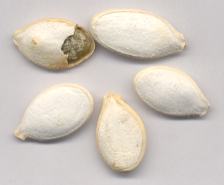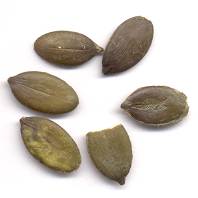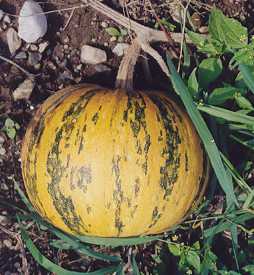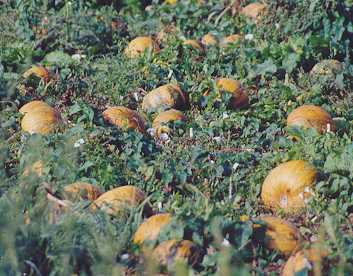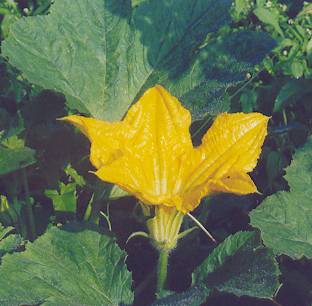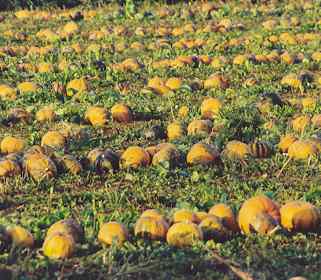| ||
|
In most European (and other) countries, pumpkin is a popular vegetable, but it is grown as an oil plant only in a small region in Central Europe, at the junction of Austria, Slovenia and Hungary. Pumpkin seed oil has a low smoke point and an exceptionally strong flavour which is comparable only to Chinese dark sesame oil, and is therefore not commonly used as a cooking medium; instead, it is valued as a salad oil and is occasionally used to flavour other types of food.
Pumpkin seed oil (German Kürbiskernöl) is extracted from pumpkin seeds that have been coarsely ground and toasted at temperatures of about 60 °C. Only by this procedure, its typical flavour is developed; pumpkin seed oils obtained by cold extraction are comparably tasteless. In the last years, production of pumpkin seed oil has much increased, since Austria’s EU membership has opened new markets; still, agriculture and production of the oil is mostly restricted to Styria (Steiermark), a federal state in South Eastern Austria (which actually happens to be the place where I have been born and raised).
Styrian pumpkin seed oil is a dark greenish–black liquid, reddish on
reflection and has an intense, nutty odour and flavour. It is often termed
the Styrian Black Gold
in reference to its dark colour similar to
petroleum. In Styria, this oil is mostly used for salads, particularly
lettuce: The lettuce leaves (almost dry if possible) are mixed with the
oil such that a thin coating of oil is formed on the lettuce surface; then,
the salad is finished by adding vinegar, salt and minced
garlic, and occasionally herbs like
chives or lovage.
If done correctly, most of the oil attaches to the leaves, and there
are only few oil drops swimming on the vinegar: Even here in
Steiermark, pumpkin seed oil is expensive, a typical
price being 15 € per liter.
In Steiermark, pumpkin seed oil is also used to prepare salads
from boiled beef, beans, potatoes and tomatoes, typically in conjunction with
onion slices and garlic. Furthermore, it is used to
flavour bread spreads based on cottage cheese. It is not used as a cooking
medium, mainly because it does not tolerate heat very well and easily develops
a burnt
flavour; yet in the rural
areas where it is produced, people sometimes prepare scrambled eggs with
pumpkin seed oil as frying medium (Kernölschmölzi, almost
untranslatable). Both because of the extremely intensive pumpkin seed flavour
and the funny colour, this dish is reserved for true lovers of pumpkin seed
oil only.

|
| … and then the seeds are separated mechanically. The pumpkin waste remains on the field. |
Outside of Styria, pumpkin seed oil is either traded as a mixture with up to
80% of bland vegetable oil (euphemistically termed salad oil
, but
junk oil
would be fitter—well, I am a Styrian), or in pure form as
an expensive delicacy. Despite the high price, it gains more friends year by
year. It is a versatile flavouring, and the incomparable flavour invites
daring cooks to try innumerous experiments: It can be used to lend a particular
flavour to sauces (e. g., a most unusual mayonnaise, see tarragon about emulgated sauces), it is a good
last-minute flavouring to be sprinkled over foods, and it is well-suited
for flavourful vinaigrettes of various kinds.
A rule of thumb says that all food that could be enriched with toasted
pumpkin seeds will also profit from adding some pumpkin seed oil. In fact, I
have even seen rye breads (see also blue fenugreek)
that contained pumpkin seed oil. It has become common practice among restaurant
chefs to add a few drops of pumpkin seed oil to pumpkin vegetable stews and
pumpkin soups, to enforce a stronger pumpkin aroma. Thus, pumpkin seed oil
shares the fate of other herbs and flavourings that have become popular,
and even become hyped, in the last years, hopefully not to fall into oblivion
in the years to come (other examples are rocket,
coriander or basil).
Personally, I often use it to improve the flavour of
Mexican sauces and stews, even if some might frown on this habit. It is
really good in chili con carne, especially when prepared
with green chiles and tomatillos (tomates verdes) instead of tomatoes. Such a food would be
called chili verde in the USA.
